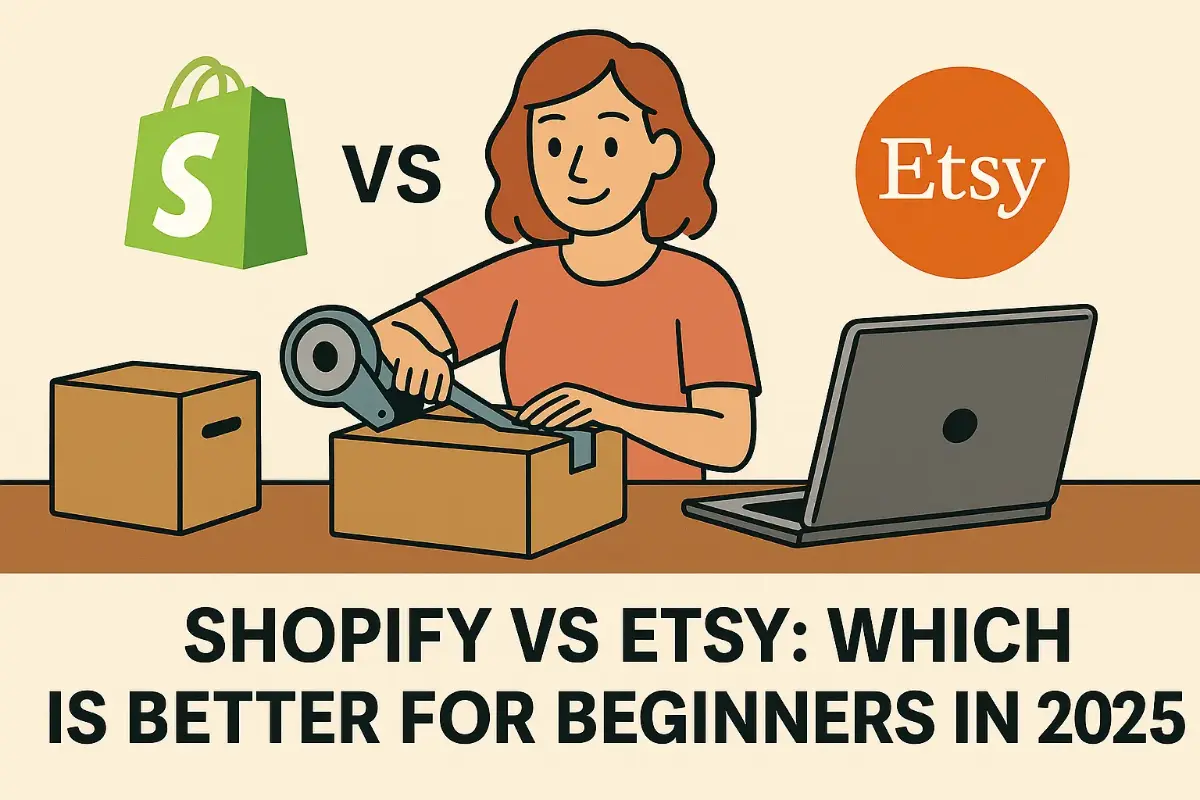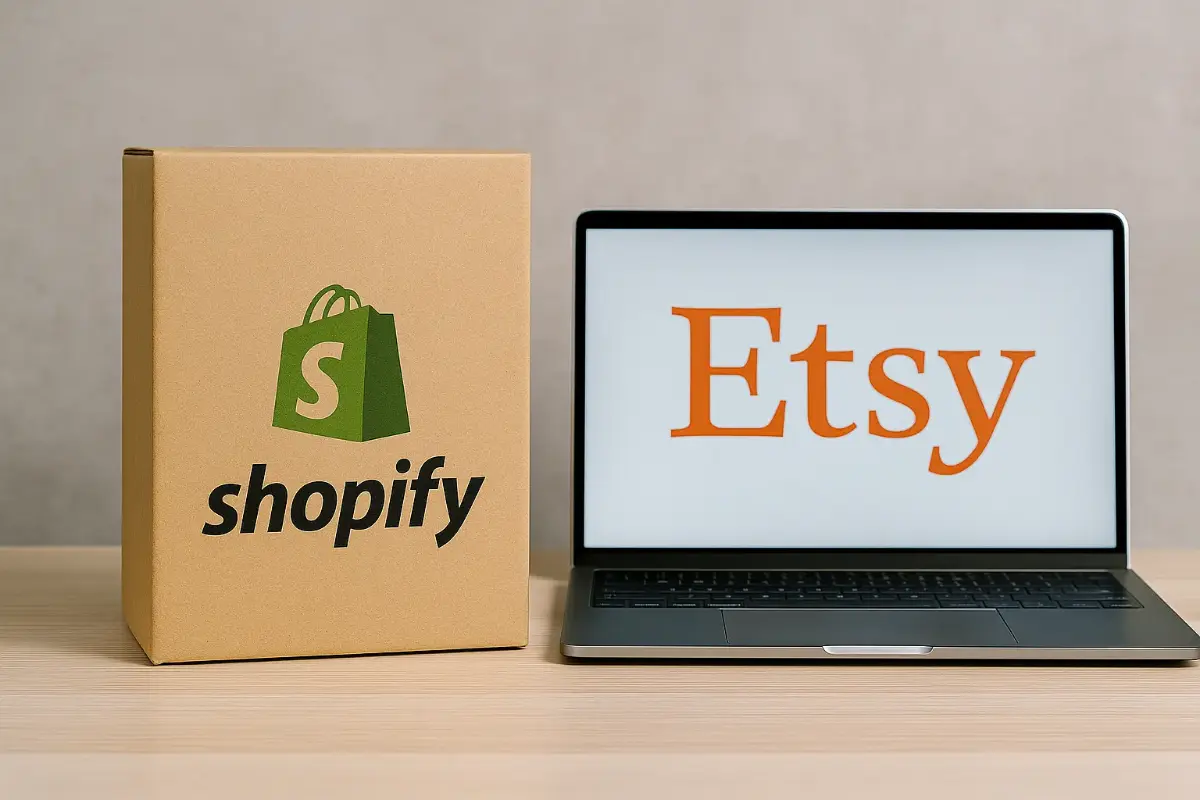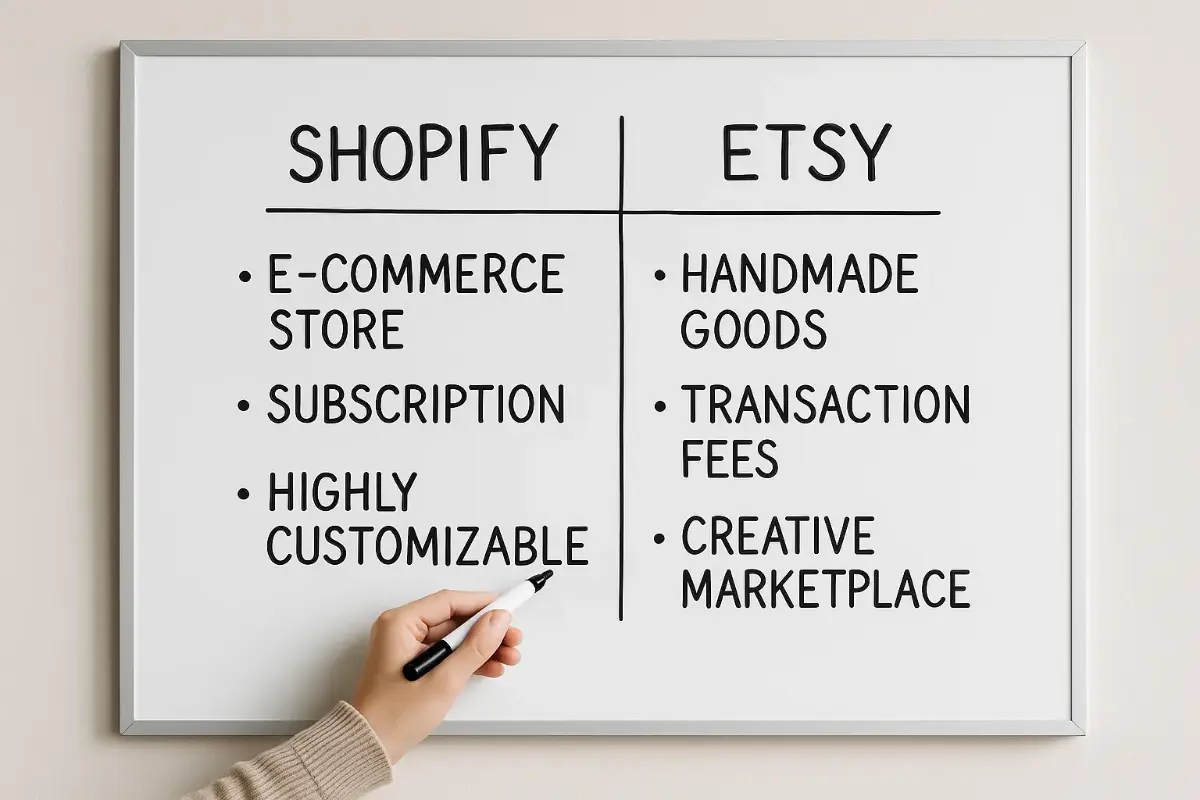Shopify vs Etsy: Which Is Better for Beginners in 2025?
Choosing between Shopify and Etsy can feel overwhelming as a beginner. I’ll walk you through the real differences, costs, pros, and cons — plus my honest take on which platform is best for you in 2025.

When I first started thinking about selling online, I kept bouncing back and forth between Shopify and Etsy. On one hand, Etsy looked super beginner-friendly — you just list your products and get access to a giant marketplace of buyers. On the other, Shopify felt like the “serious” option, where you could build your own store and brand.
The problem was, I didn’t know which one actually made sense for me. I wanted something simple, but I also didn’t want to waste time building in the wrong place. If you’ve been stuck asking yourself “Should I use Shopify or Etsy?” — trust me, you’re not alone.
In this guide, I’ll break down the real differences, share the pros and cons of each, and give you my beginner perspective on which one works best depending on your goals.
The Big Picture: What’s the Difference?
Here’s the simplest way I can explain it:
- Etsy is a marketplace. Think of it like renting a booth at a busy market. The shoppers are already there, walking around, looking for handmade, vintage, or unique products. You just set up your table and try to stand out.
- Shopify is a platform. It gives you the tools to build your own online shop from scratch. You’re not sharing space with thousands of other sellers, but you’re also responsible for bringing in your own customers.
Both are great in different ways. Etsy gives you quick access to a built-in audience, while Shopify gives you full control to build a brand that’s 100% yours. The tricky part is figuring out which one matches where you are on your journey.
Why Beginners Get Stuck Choosing
When I was weighing up my options, I kept running into the same dilemma:
- Etsy seemed easier because the traffic is already there. I liked the idea of not worrying about marketing right away.
- Shopify felt more professional, but I was intimidated by the thought of having to bring in my own traffic.
It felt like choosing between quick wins and long-term growth. Do I go with the platform that gets me started faster, or the one that sets me up better for the future?
If you’re struggling with the same choice, don’t worry — that’s exactly what we’re going to untangle in the rest of this article.
Shopify at a Glance
When I first explored Shopify, it felt a little overwhelming — like opening the doors to a blank shop and realizing I had to figure out the layout, the signage, and how to get customers in the door. But once I played around with the templates, I realized Shopify actually does a lot of the heavy lifting.
The pros:
- You have complete control over your store’s look and feel.
- Tons of apps and integrations to add features as you grow.
- Scales well — whether you’re selling one product or hundreds.
The cons:
- Monthly cost (starting at around $25/month).
- No built-in traffic — you’re responsible for bringing people in.
- Can feel like “too much” if you just want to test an idea.

Etsy at a Glance
Etsy, on the other hand, felt way simpler the first time I tried it. Instead of designing a whole shop, you just create a listing and put it in front of millions of Etsy shoppers who are already browsing.
The pros:
- Super easy setup — you can list your first product in under an hour.
- Built-in audience of people who trust Etsy for handmade, vintage, and unique goods.
- No need to worry about hosting, design, or tech.
The cons:
- Listing and transaction fees that add up over time.
- High competition — you’re side by side with thousands of similar products.
- Limited control over branding and store design.
Side-by-Side Comparison: Shopify vs Etsy
When I was stuck between Shopify and Etsy, I realized it wasn’t enough to just look at the pros and cons. I needed to see how they compared directly in the areas that actually mattered for me as a beginner. Here’s the breakdown:
1. Setup & Ease of Use
- Etsy: You can sign up, add photos, write a description, and publish a product listing in under an hour. No design, no coding, no setup headaches. It honestly feels like posting an item for sale on eBay.
- Shopify: Setup takes longer because you’re creating a whole store. You’ll need to choose a theme, customize it a bit, and connect payment options. That said, Shopify’s templates are drag-and-drop, so you don’t need to be a tech wizard.
2. Costs & Fees
- Etsy: No monthly subscription, but the fees add up:
- $0.20 listing fee per product.
- 6.5% transaction fee on each sale.
- 3% + $0.25 payment processing fee (in the U.S.).
- Optional: offsite ads, which can take another 12–15% cut.
- Shopify: Starts at about $25/month for the Basic plan. Transaction fees are 2.9% + $0.30 per sale unless you use Shopify Payments. No listing fees.
3. Design & Branding
- Etsy: Your shop looks like every other Etsy shop, with the same layout. You can upload a banner and logo, but that’s about it.
- Shopify: Complete freedom to design your store with themes, colors, and layouts that match your brand. You can make your store look unique and professional, even as a beginner.
4. Marketing & Traffic
- Etsy: This is where Etsy shines. Shoppers already go there to buy handmade and unique goods, so you can “borrow” their traffic. The catch? You’re competing with thousands of other sellers, and your product needs to stand out in Etsy search.
- Shopify: No built-in traffic. You’re responsible for getting visitors through SEO, social media, email, or ads. It’s more work, but you also own the customer relationship.
5. Scalability & Growth
- Etsy: Great for testing ideas and making early sales. But you’re limited by Etsy’s rules and algorithms. If Etsy changes its fees or policies, you have to adapt.
- Shopify: Built for growth. You can add apps, sell across multiple channels (Instagram, TikTok, Amazon), and scale without worrying about platform limits.
6. Product Types & Audience
- Etsy: Best for handmade, vintage, custom, and unique items. Buyers go there specifically for this type of product.
- Shopify: Works for almost anything — physical products, digital downloads, dropshipping, subscriptions, or services.

Comparison Table
When I saw this comparison laid out, the trade-offs became a lot clearer. Etsy is quick and simple to start, but Shopify gives you freedom and room to grow. The “right” choice depends on whether you’re testing an idea or building a business.
My Beginner Take: Which Should You Choose?
When I was weighing Shopify and Etsy, I kept asking myself: “Do I want to start fast, or do I want to build for the future?”
If I had zero audience and just wanted to test a product idea — say handmade jewelry or digital prints — I’d probably start on Etsy. The built-in audience is hard to ignore, and you can make your first sale without running ads or learning SEO. That confidence boost matters when you’re new.
But if I was serious about building a long-term brand — with my own email list, social media following, and returning customers — I’d choose Shopify. You own the platform, the customer relationship, and the look of your store. It’s a bigger upfront commitment, but it pays off if you stick with it.
Here’s a little secret: some sellers actually use both. They start on Etsy to get quick traction, then build a Shopify store alongside it for branding and growth. That way, Etsy brings in discovery sales, while Shopify becomes the hub they truly own.
Tips for Success on Either Platform
No matter which one you choose, success comes down to more than just picking the right platform. Here are a few beginner tips that helped me:
- On Etsy:
- Use high-quality photos — images are everything in a crowded marketplace.
- Research Etsy SEO — keywords in your titles and descriptions help you show up in search.
- Niche down — don’t try to sell everything; focus on one style or category so buyers recognize your shop.
- On Shopify:
- Don’t skip marketing — set up email capture from day one, even if you only get a handful of sign-ups.
- Keep your design clean and simple — don’t overload with apps or fancy features you don’t need.
- Learn traffic basics — a mix of social media, SEO, and maybe some light ads can go a long way.
The most important lesson I’ve learned? Whichever platform you start with, expect a learning curve. Your first listing or store won’t be perfect. But if you’re willing to experiment and tweak things along the way, you’ll keep moving closer to the kind of store you want to run.
Final Thoughts
When I first looked at Shopify vs Etsy, I thought there had to be a clear winner. But the truth is, it really depends on what stage you’re at and what you want to build.
If you just want to test an idea or sell a few handmade items, Etsy is the fastest way to get started. You can ride their built-in traffic and learn the basics of selling online without much risk.
If you’re ready to invest in a brand and take control of your business, Shopify is the better long-term choice. It’s more work upfront, but you own your store, your customers, and your growth.
There’s no “wrong” answer here — just different paths. Start simple, learn as you go, and don’t be afraid to switch or even use both as your business grows. The key is to get moving and see what works for you.
And if you want more step-by-step help, check out the E-commerce & Dropshipping Beginner's Guide and my Beginner’s Guide to Starting an Online Business for more beginner-friendly comparisons and tutorials.
